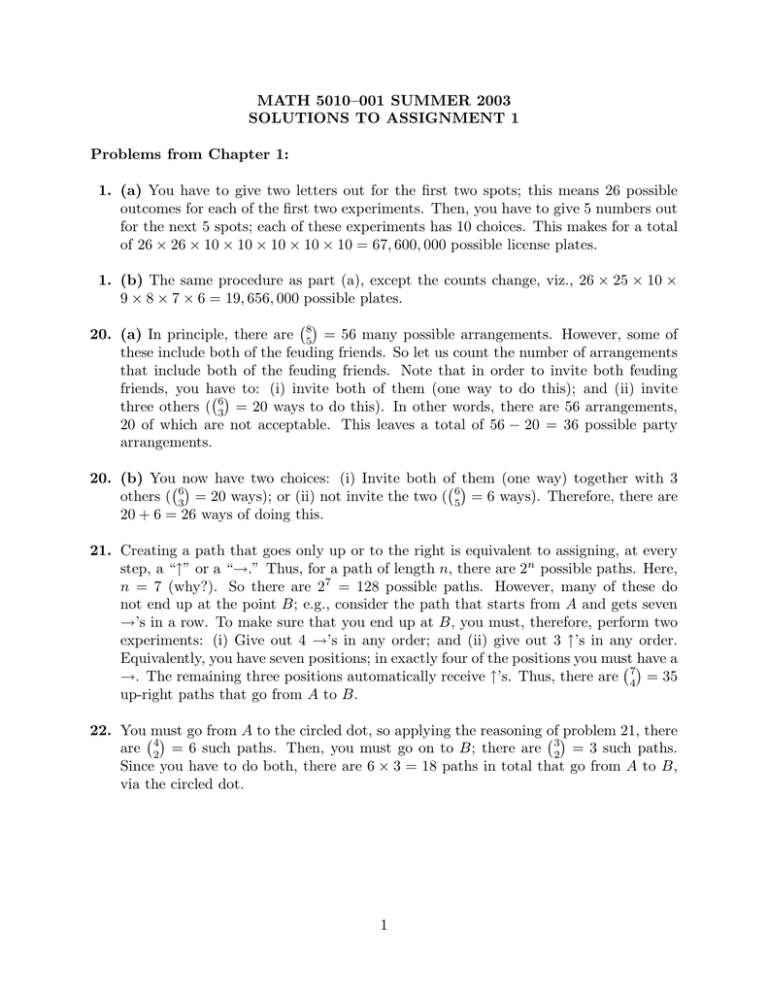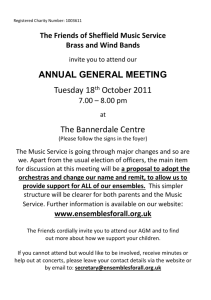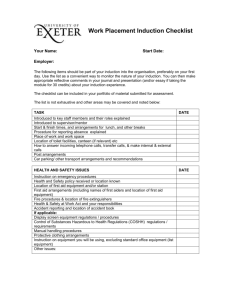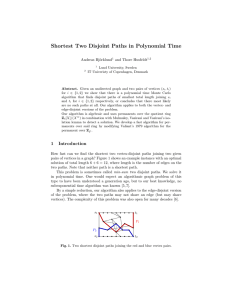MATH 5010–001 SUMMER 2003 SOLUTIONS TO ASSIGNMENT 1 Problems from Chapter 1:
advertisement

MATH 5010–001 SUMMER 2003 SOLUTIONS TO ASSIGNMENT 1 Problems from Chapter 1: 1. (a) You have to give two letters out for the first two spots; this means 26 possible outcomes for each of the first two experiments. Then, you have to give 5 numbers out for the next 5 spots; each of these experiments has 10 choices. This makes for a total of 26 × 26 × 10 × 10 × 10 × 10 × 10 = 67, 600, 000 possible license plates. 1. (b) The same procedure as part (a), except the counts change, viz., 26 × 25 × 10 × 9 × 8 × 7 × 6 = 19, 656, 000 possible plates. 20. (a) In principle, there are 85 = 56 many possible arrangements. However, some of these include both of the feuding friends. So let us count the number of arrangements that include both of the feuding friends. Note that in order to invite both feuding friends, you have to: (i) invite both of them (one way to do this); and (ii) invite three others ( 63 = 20 ways to do this). In other words, there are 56 arrangements, 20 of which are not acceptable. This leaves a total of 56 − 20 = 36 possible party arrangements. 20. (b) You now have two choices: (i) Invite both of them (one way) together with 3 others ( 63 = 20 ways); or (ii) not invite the two ( 65 = 6 ways). Therefore, there are 20 + 6 = 26 ways of doing this. 21. Creating a path that goes only up or to the right is equivalent to assigning, at every step, a “↑” or a “→.” Thus, for a path of length n, there are 2n possible paths. Here, n = 7 (why?). So there are 27 = 128 possible paths. However, many of these do not end up at the point B; e.g., consider the path that starts from A and gets seven →’s in a row. To make sure that you end up at B, you must, therefore, perform two experiments: (i) Give out 4 →’s in any order; and (ii) give out 3 ↑’s in any order. Equivalently, you have seven positions; in exactly four of the positions you must have a →. The remaining three positions automatically receive ↑’s. Thus, there are 74 = 35 up-right paths that go from A to B. 22. You must go from A to the circled dot, so applying the reasoning of3problem 21, there 4 are 2 = 6 such paths. Then, you must go on to B; there are 2 = 3 such paths. Since you have to do both, there are 6 × 3 = 18 paths in total that go from A to B, via the circled dot. 1 Theoretical Problems from Chapter 1: 8. As in the hint, let there be n men and m women, and assume throughout that r is a positive integer that is less than n and m both. We first need a combinatorial lemma. Lemma. If A1 , . . . , Ak are disjoint, and if Aj has nj elements, then A1 ∪ · · · ∪ Ak has (n1 + · · · + nk )-many elements. Proof: We prove this by induction. If k = 1, then there is nothing to prove. Now suppose that it is valid for k − 1, and prove it is valid for k. Since the Aj ’s are disjoint, then so are B := (A1 ∪ · · · ∪ Ak−1 ) and Ak . Therefore, by the induction hypothesis, the number of elements of B ∪ Ak is the number of elements of B plus nk . Once again, we apply the induction hypothesis to see that the number of elements of B is n1 + · · · + nk−1 . Therefore, B ∪ Ak has (n1 · · · + nk )-many elements. But B ∪ Ak is just another way of writing A1 ∪ · · · ∪ Ak . Now define A1 , . . . , Ar+1 to be the following events: For any j = 1, . . . , r+1, let Aj denote the event that we choose exactly (j −1) men and the remaining (r −j +1) women. m n Clearly, the number nj of elements of Aj is j−1 r−j+1 . Therefore, the number of Pr+1 n m elements of A1 ∪ A2 ∪ · · · ∪ Ar+1 is, by the preceding lemma, j=1 j−1 r−j+1 . On the other hand, A1 ∪ · · · ∪ Ak is the event that we choose r people. So there are n+m r elements in A1 ∪ · · · Ak . Since the two calculations must lead to the same number, we must have X r+1 n+m n m = , (1) r j + 1 r − j + 1 j=1 as asserted. Note: This formula is valid for any integer r—not only the ones that are less than k n and m—as long as we define r to be zero for r < k. (This is a very natural definition; why?) 9. Replace m and n by 2n both, and r by n. This and (1), together yield n+1 X n X n 2n n n n = = , n j+1 n−j+1 k n−k j=1 (2) k=0 upon letting k := j +1. We obtain the desired result by recalling the identity, n k . 2 n n−k =




![MA1124 Assignment5 [due Monday 16 February, 2015]](http://s2.studylib.net/store/data/010730348_1-77b9a672d3722b3831a1e52597d5a881-300x300.png)
